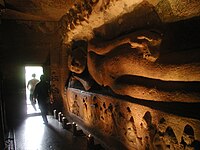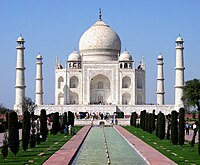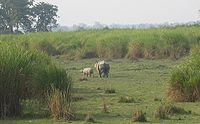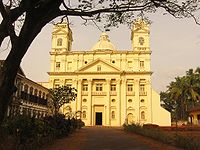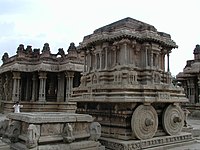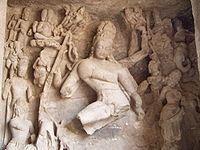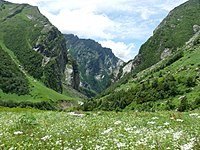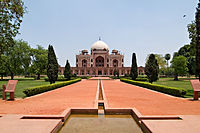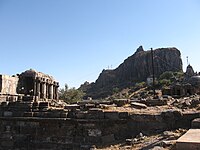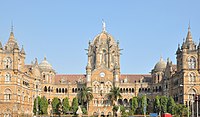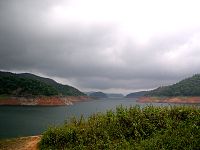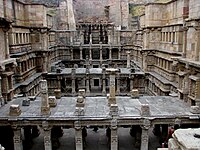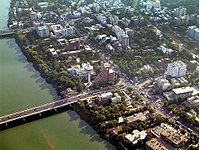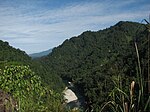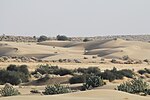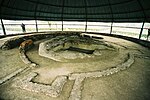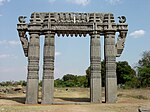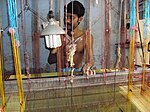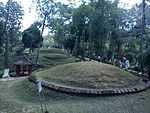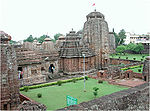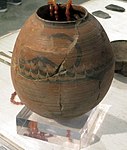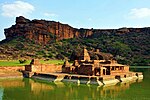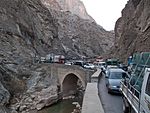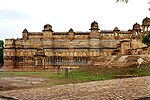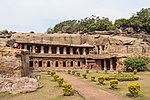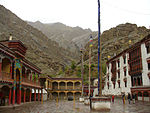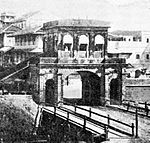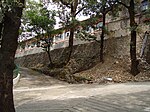World Heritage in India
The world heritage in India (as of 2019) includes 38 UNESCO world heritage sites , including 30 world cultural heritage sites, seven world natural heritage sites and a mixed cultural and natural heritage site. India ratified the World Heritage Convention in 1977, and the first four World Heritage sites were added to the World Heritage List in 1983. The last World Heritage site to date was registered in 2019.
World heritage sites
The following table lists the UNESCO World Heritage Sites in India in chronological order according to the year of their inclusion on the World Heritage List (K - cultural heritage, N - natural heritage, K / N - mixed, (R) - on the Red List of World Heritage in Danger ).
![]() Map with all coordinates of World Heritage Sites: OSM
Map with all coordinates of World Heritage Sites: OSM
| image | designation | year | Type | Ref. | description |
|---|---|---|---|---|---|
|
Ajanta rock temple ( location ) |
1983 | K | 242 | The Ajanta Caves are located near the city of Ajanta in the northeast of the Indian state of Maharashtra , about 100 km north of the city of Aurangabad . In a U-shaped valley cut steeply into the rock by the Waghora River , there are numerous large cave temples carved into the rock . Most of the caves were built during the Vakataka Dynasty in the 5th century. | |
|
Ellora cave temple ( location ) |
1983 | K | 243 | Complex of 34 cave temples in the Indian state of Maharashtra. The entire complex was carved out between the 5th and 11th centuries AD as part of the Deccan architecture from a basaltic rock wall over 2 km long from southeast to northwest. The buildings are divided into a Buddhist (approx. 400–800 AD), a Hindu (approx. 600–900 AD) and a Jain group (approx. 800–1100 AD). | |
|
Agra, Red Fort ( location ) |
1983 | K | 251 | The Red Fort in Agra is a fortress and palace complex from the era of the Mughal emperors and served, with interruptions, as the residence of the Mughals in the 16th and 17th centuries. The architectural style harmoniously combines elements of Islamic and Hindu architecture. | |
|
Agra, Taj Mahal ( location ) |
1983 | K | 252 | The Taj Mahal is a 58 meter high and 56 meter wide mausoleum , which was built in Agra in the Indian state of Uttar Pradesh on a 100 × 100 meter marble platform. Mughal Mughal Shah Jahan had it built in memory of his main wife Mumtaz Mahal (Arjumand Bano Begum), who died in 1631 . Because of the harmony of its proportions, it is considered to be one of the most beautiful and important examples of the Mughal style. | |
|
Konarak Sun Temple ( location ) |
1984 | K | 246 | The temple complex was built in the middle of the 13th century under King Narasimha Deva (1238–1264) and was abandoned a short time later or even during the construction. On the high base of the temple there are 24 large wagon wheels carved out of the stone, remains of the draft horses and an enormous number of detailed smaller representations. Many of them depict people engaged in sexual acts. | |
|
Mahabalipuram Temple District ( Location ) |
1985 | K | 249 | The coastal temple is located directly on the beach of Mamallapuram (Mahabalipuram); Built at the end of the 8th century under the Pallava king Rajasimha Narasimhavarman II, it is one of the oldest stone temples in South India. The Pancha Ratha (" five Rathas ") are a group of five monolithic temples located around one and a half kilometers south of the town center. The descent of the Ganga is a bas-relief created in the 7th century; At 12 meters high and 33 meters wide, it is one of the largest in the world. | |
|
Kaziranga National Park ( location ) |
1985 | N | 337 | National park in the state of Assam in the mountainous landscape of the Karbi Anglong district in northeast India. The national park is the most important protected area for the Indian rhinoceros and is home to over 70% of the world's total population. Kaziranga is also one of the most important protected areas for wild water buffalo , Asian elephants , Bengal tigers and barasingha deer . | |
|
Manas Wildlife Sanctuary ( location ) |
1985 | N | 338 | National Park in the Indian state of Assam at the foot of the Himalayas; borders the Royal Manas National Park in Bhutan . The park is particularly known for its numerous endangered mammals, such as Asian elephants, king tigers, wild water buffalo, barasingha deer, golden langurs and pygmy boars . | |
|
Keoladeo National Park ( location ) |
1985 | N | 340 | National park in the Indian state of Rajasthan , also called Bharatpur Bird Sanctuary or Keoladeo Ghana Bird Sanctuary. Many waterfowl from Afghanistan, Turkmenistan, China and Siberia overwinter in the swampy landscape. Over 364 species of birds including the rare barnacle crane have been observed. | |
|
Churches and Monasteries of Goa ( location ) |
1986 | K | 234 | A total of 60 churches in Velha Goa, built when Goa was the capital of the Portuguese colony Portuguese India . | |
|
Khajuraho Temple District ( Location ) |
1986 | K | 240 | A group of around 20 temples in the center and in the vicinity of the city of Khajuraho in the Indian state of Madhya Pradesh , built by the rulers of the Chandella dynasty between 950 and 1120. The majority of the temples are dedicated to the main Hindu gods, some to the Jain- Tirthankaras . | |
|
Temple district of Hampi ( location ) |
1986 | K | 241 | The most elaborate and best preserved temples in the Vijayanagara style date from the 14th to 16th centuries. Century. The peak of this style is reached at the Vitthala Temple from the middle of the 15th century. It stands in the north near the river, three high gopurams (gate towers) delimit an area of 164 × 94 meters. | |
|
Mughal city of Fatehpur Sikri ( location ) |
1986 | K | 255 | Former capital of the Mughal Empire under Mughal Emperor Akbar I (1542–1605), built between 1569 and 1574. In 1571 Akbar moved here with his court, but in 1585 he moved the court to Lahore . | |
|
Pattadakal Temple Complex ( location ) |
1987 | K | 239 | Temple buildings of the Chalukya dynasty from the 7th and 8th centuries, which are among the most important of the early Indian stone temples. North and South Indian architectural styles can be found next to each other within the ten temples in this group. | |
|
Elephanta Caves ( location ) |
1987 | K | 244 | On the rocky and still densely forested island of Elephanta there are a total of six caves, which were mainly used to worship Shiva . Two of them are on the slope of the northwest of the two hills. In the middle of the island, on the eastern slope of the western hill, there are four other cave temples, including the main cave. | |
|
Great Temple of the Chola Dynasty ( location ) |
1987 | K | 250 | Three Hindu temples from the time of the Chola dynasty (9th to 13th centuries) in the southern Indian state of Tamil Nadu .
In 1987 the Brihadisvara Temple in Thanjavur was added to the World Heritage List. In 2004 the world heritage site was expanded to include the Brihadishvara Temple in Gangaikonda Cholapuram and the Airavatesvara Temple in Darasuram |
|
|
Sundarbans National Park ( location ) |
1987 | N | 452 | The largest mangrove forests on earth. The species-rich ecosystem is widely ramified and difficult to access, especially because the delta areas of the Ganges , Brahmaputra and Meghna merge here. The endangered Bengal tiger and the endemic Sundari tree are native here. | |
|
Nanda Devi National Park and Valley of Flowers National Park ( location ) |
1988 | N | 335 | The world heritage site originally only included the Nanda Devi National Park in Uttarakhand and was expanded in 2005 to include the adjacent Valley of Flowers National Park . | |
|
Buddhist sanctuary near Sanchi ( Lage ) |
1989 | K | 524 | The eight oldest stupas in and at Sanchi (the old name of the place is 'Kakanaya' or 'Kakanadabota') and one of his famous columns were during the reign of King Ashoka of the Maurya Dynasty (r. Ca. 268-232 v. Chr .) built. Further stupas and other religious buildings (temples, monasteries) were added - mostly as part of foundations - up to the 12th century. Sanchi is mainly known because of the partly from the 3rd century BC. Buddhist stupas dating back to the 3rd century BC, which are among the oldest structures of this type still in existence. | |
|
Tomb of Emperor Humajun in Delhi ( location ) |
1993 | K | 232 | The Humayun mausoleum in Delhi is the burial place of Humayun (1508–1556), the second ruler of the Mughal Empire of India. Due to its size and elegant Persian-style architecture, it is one of the most magnificent historical buildings on the entire subcontinent. Its imposing architecture points to the Akbar mausoleum in Sikandra and the Taj Mahal in Agra . | |
|
Kutub Minar with its mosques and tombs in Delhi ( location ) |
1993 | K | 233 | The Qutb complex is an area in Mehrauli in the south of the Indian capital Delhi , on which the ruins of the first mosque in Delhi - built after the Muslim conquest of the city - stand (around 1200). The Qutub Minar is a victory and watchtower as well as a minaret within the complex of several buildings from the early days of the Sultanate of Delhi . It is considered an early masterpiece of Indo-Islamic architecture and is still one of the tallest towers in the Islamic world. | |
|
Mountain railways in India ( location ) |
1999 | K | 944 | Three mountain railways in India. All three railways are narrow-gauge lines that were laid out towards the end of the 19th century during the British colonial period in order to open up the mountain towns that were previously difficult to reach.
The world heritage site originally only included the Darjeeling Himalayan Railway , the Nilgiri Mountain Railway was added in 2005, and the Kalka-Shimla Railway in 2008 |
|
|
Mahabodhi Temple of Bodh Gaya ( location ) |
2002 | K | 1056 | Buddhist temple in Bodhgaya in the northeastern Indian state of Bihar , which was originally built in the 2nd century. On the west side of the temple is the poplar fig , under which Siddhartha Gautama , the historical Buddha, according to tradition , attained the awakening ( Bodhi ). | |
|
Bhimbetka rock caves ( location ) |
2003 | K | 925 | Archaeological site in the Indian state of Madhya Pradesh. There you can find Stone Age paintings in rock shelters that are up to 9000 years old. Bhimbetka is one of the oldest petroglyphs in India. | |
|
Champaner-Pavagadh Archaeological Park ( location ) |
2004 | K | 1101 | Mostly not yet excavated early Hindu city. In addition to remnants of the former capital of Gujarat from the 16th century, it includes a hill fortress of an early Hindu capital as well as fortifications, religious buildings, palaces and residential buildings from the 8th to 14th centuries. | |
|
Chhatrapati Shivaji Terminus in Mumbai ( location ) |
2004 | K | 945 | Station of the Indian Railways in the south of Mumbai . It is one of the largest and busiest train stations in the world. The station building is a symbiosis of British architecture and building art as well as Indian structural elements and craftsmanship and is architecturally unique of its kind. Completed in 1888, it was considered the largest and most important building in British India . | |
|
Red Fort ( location ) |
2007 | K | 231 | Fortress and palace complex in Delhi from the era of the Mughal Empire. It was built between 1639 and 1648 for Mughal Emperor Shah Jahan. | |
|
The "Jantar Mantar" in Jaipur ( location ) |
2010 | K | 1338 | The largest of the five historical astronomical observatories that Maharaja Jai Singh II had built; was built on the model of the observatory in Delhi in the new capital Jaipur from 1727 to 1733. It houses 14 buildings designed according to astronomical criteria. These are used, among other things, to measure time, predict eclipses, observe the orbits of the planets, determine astronomical altitude and declination, and create ephemeris . | |
|
Western Ghats Mountains ( location ) |
2012 | N | 1342 | 39 protected areas in the Western Ghats, a mountain range that runs along the edge of the Dekkan Plateau and separates it from the narrow strip of the coastal plain and the Arabian Sea. The Western Ghats are one of the world's most important biodiversity hotspots. | |
|
Mountain fortresses of Rajasthan ( location ) |
2013 | K | 247 | The forts of Chittorgarh , Kumbhalgarh , Sawai Madhopur , Jhalawar , Jaipur , Jaisalmer . | |
|
Great Himalayan National Park ( location ) |
2014 | N | 1406 | The protected area includes tropical to alpine climates and also includes Tibetan steppe regions. A total of 31 species of mammals and 181 species of birds have been identified in the park so far. | |
|
Rani Ki Vav (Queen's Stepwell) in Patan, Gujarat ( location ) |
2014 | K | 922 | The Rani Ki vav in Patan is the most magnificent of all the stepwells in Gujarat. It is decorated with figures and abstract vegetable reliefs and was built to catch the abundant rainwater during the monsoon season, but also to get to the groundwater. | |
|
Nalanda Mahavihara archaeological site ( location ) |
2016 | K | 1502 | Ruined city with a Buddhist university founded in the 5th century | |
|
Kangchenjunga National Park ( location ) |
2016 | K / N | 1513 | 1,784 km² protected area on the border with Nepal. | |
|
The architectural work of Le Corbusier ( location ) |
2016 | K | 1321 | The world heritage site comprises 17 buildings by the architect Le Corbusier . The buildings show the solutions that modernity offered in the 20th century for the challenges of inventing new architectural techniques in order to meet the needs of society. In India, the capitol complex in Chandigarh is a World Heritage Site , the other buildings are in France , Argentina , Belgium , Germany , Japan and Switzerland . | |
|
Ahmedabad old town ( location ) |
2017 | K | 1551 | ||
|
Victorian Gothic and Art Deco ensembles in Mumbai ( location ) |
2018 | K | 1480 | Comprises a neo-Gothic Victorian-style ensemble of buildings in the Fort District of Mumbai and Art Deco- style buildings to the west on Back Bay . The buildings illustrate these architectural styles as well as Bombay's transformation from a British trading post and fort to the first city in India. | |
|
Jaipur, Rajasthan ( location ) |
2019 | K | 1605 | Jaipur was planned from 1727 under Jai Singh II . The plan, after Jaipur was laid out as a grid, shows influences of ancient Hindu and Mughal cultures as well as western impulses. The facades on the main squares and streets are designed uniformly, many markets and shops are harmoniously present behind colonnades . The handicrafts of Jaipur, which are still alive today, are also remarkable. |
Tentative list
The sites that are intended for nomination for inclusion in the World Heritage List are entered in the tentative list .
Current World Heritage candidates
As of 2019, there are 43 sites in the tentative list of India, the last entry was in 2019. The following table lists the sites in chronological order according to the year they were included in the tentative list.
![]() Map with all coordinates of current World Heritage candidates: OSM
Map with all coordinates of current World Heritage candidates: OSM
| image | designation | year | Type | Ref. | description |
|---|---|---|---|---|---|
| Bishnupur Temple | 1998 | K | 1087 | In the city of Bishnupur in West Bengal there are several Bengali temples from the 17th century. | |
|
Mattancherry Palace ( location ) |
1998 | K | 1092 | ||
| Group of monuments in Mandu, Madhya Pradesh | 1998 | K | 1095 | comprises 61 structures in the city of Mandu in Madhya Pradesh | |
| Sarnath and Varanasi ancient Buddhist sites | 1998 | K | 1096 | Gautama Buddha taught the Dharma in Sarnath and Varanasi in Uttar Pradesh . | |
|
Sri Harimandir Sahib ( location ) |
2004 | K | 1858 | The "Golden Temple" in Amritsar in Punjab is the holiest temple in Sikhism | |
|
Majuli River Island ( location ) |
2004 | N | 1870 | Majuli is a river island in the Brahmaputra River in Assam | |
|
Namdapha National Park ( location ) |
2006 | N | 2104 | The largest protected landscape in the Eastern Himalayas in Arunachal Pradesh | |
| Dhrangadhra Game Reserve | 2006 | N | 2105 | The Dhrangadhra game reserve in the small Rann of Kachchh is also known as the Wild Ass Sanctuary (" Wild Ass Sanctuary ") and is known for its Indian gazelles | |
| Neora Valley National Park | 2009 | N | 5447 | ||
| Desert National Park | 2009 | N | 5448 | Example of the Thar Desert ecosystem in Rajasthan | |
| Silk Road sites in India | 2010 | K | 5492 | comprises 12 sites on the sections of the Silk Road that run through India. | |
| Shantiniketan | 2010 | K | 5495 | ||
| Qutb Shahi monuments in Hyderabad | 2010 | K | 5573 | includes buildings from the time of the Qutb Shahi dynasty in the city of Hyderabad and its surroundings: the Charminar Gate , the Golkonda Fortress and the Qutb Shahi tombs . | |
| Mughal Gardens in Kashmir | 2010 | K | 5580 | 6 Gardens in Kashmir : Shalimar-Bagh , Chashma Shahi , Pari Mahal , Verinag , Achabal Gardens and Nishat Bagh | |
| Delhi - a city of cultural heritage | 2012 | K | 5743 | ||
| Monuments and fortresses of the Deccan sultanates | 2014 | K | 5887 | Buildings and ensembles of buildings from the time of the Deccan Sultanates in Gulbarga (capital of the Bahmani Sultanate 1347–1428), Bidar (capital of the Bahmani Sultanate 1428–1492 and the Sultanate of Bidar 1492–1619), Bijapur (capital of the Sultanate of Bijapur 1490– 1686) and Hyderabad (capital of the Qutb Shāhī Sultanate 1590–1685).
The Qutb Shahi monuments in Hyderabad had already been put on the tentative list as a separate proposal (Ref. # 5573 ) in 2010 . |
|
| Cellular Jail, Andaman Islands | 2014 | K | 5888 | from 1893 built prison on the Andamans | |
| Temples and gates of the glorious Kakatiya | 2014 | K | 5889 | includes three temples and the associated free-standing gate structures ( Toranas ) from the time of the 1163-1323 ruling Kakatiya dynasty: the remains of the Swayambhu temple and the Keerthi Thoranas in Fort Warangal near Warangal , which was the capital of the Kakatiya dynasty, the Rudreswara temple (temple of a thousand columns) in Hanumakonda and Rudreswara temple (Ramappa temple) in Palampet . | |
| Iconic sari weaving cluster of India | 2014 | K | 5890 | Cluster traditional Sari -Webereien in Chanderi , Varanasi , Mubarakpur , Paithan , Yeola , Koyalagudem , Pochampalli and Sualkuchi | |
| Dholavira: A Harappa city | 2014 | K | 5892 | archaeological site of the Harappa culture in western Gujarat . | |
| Cultural landscape of the Apatani | 2014 | K | 5893 | Settlement area of the Apatani tribe in the Eastern Himalayas in the vicinity of the city of Ziro in Arunachal Pradesh , where wet rice is grown . | |
|
Sri Ranganathaswamy Temple, Srirangam ( location ) |
2014 | K | 5894 | ||
|
Monuments of the island city of Shrirangapattana ( location ) |
2014 | K | 5895 | ||
|
Chilika Lake ( location ) |
2014 | N | 5896 | ||
|
Padmanabhapuram Palace ( location ) |
2014 | K | 5897 | Wooden royal palace in Padmanabhapuram | |
| Sacred ensembles of the Hoysala | 2014 | K | 5898 | Ensembles of holy sites of the Hoysala Dynasty in Belur , the first capital of the Hoysala, and Halebid , which was the capital of the Hoysala Empire from the 12th to the 14th centuries under the name Dorasamudra . | |
| Sites of the Satyagraha, India's nonviolent freedom movement | 2014 | K | 5899 | Satyagraha is the basic attitude of non-violence propagated by Mahatma Gandhi in the struggle for independence in India. The proposal includes 22 sites in Gujarat , Maharashtra , West Bengal , Tamil Nadu , Bihar , Kerala , Uttar Pradesh , New Delhi and Madhya Pradesh . | |
|
Thembang fortified village ( location ) |
2014 | K | 5913 | ||
|
Narcondam Island ( location ) |
2014 | N | 5914 | ||
| Maidams - the burial mound system of the Ahom dynasty | 2014 | K | 5915 | Maidams are tumuli of the Ahom dynasty which from 1228 to 1826 in Assam ruled. | |
|
Ekamra Kshetra - The Temple City ( location ) |
2014 | K | 5916 | Ekamra Kshetra is a historical name for the city of Bhubaneswar , in which there are about 35 important temples for the history of Hindu temple architecture in East India. | |
|
Neolithic settlement Burzahom ( location ) |
2014 | K | 5917 | ||
|
Archaeological remains of the Harappa port city of Lothal ( location ) |
2014 | K | 5918 | Lothal was a port city of the ancient Harappa culture | |
| Mountain railways in India | 2014 | K | 5919 | Planned expansion of the existing World Heritage Site (Ref. # 944 ) to include Kangra Valley Railway and Matheran Hill Railway | |
| Chettinad, village cluster of Tamil merchants | 2014 | K | 5920 | comprises three clusters with a total of eleven villages in the region Chettinad in Tamil Nadu . | |
|
Bahai Temple in New Delhi ( location ) |
2014 | K | 5921 | ||
| Development of temple architecture - Aihole-Badami-Pattadakal | 2015 | K | 5972 | Planned expansion of the existing world heritage site of Pattadakal (Ref. # 239 ) to include temples in Aihole and Badami | |
|
Cultural landscape of the cold desert of India ( location ) |
2015 | K | 6055 | Mountainous cultural landscape with a cold and dry climate between the mountain ranges of the Himalayas and the Karakoram from Ladakh in the north to Kinnaur in Himachal Pradesh in the south
The proposal also includes the monasteries Alchi and Hemis , which were previously proposed separately . |
|
| Sites along Grand Trunk Road | 2015 | K | 6056 | The serial world heritage site comprises 93 individual sites along the Grand Trunk Road , one of the oldest and most important transport links in Asia, which was also known as Uttarapatha , Sadak-e-Azam or Badshahi Sadak in different historical periods . | |
|
Keibul Lamjao National Park ( location ) |
2016 | K / N | 6086 | Protection reserve in Manipur for the conservation of the threatened Manipur lyre deer from the genus of the lyre deer . | |
| Garo Hills Conservation Area (GHCA) | 2018 | K / N | 6356 | ||
| Orchha historical ensemble | 2019 | K | 6404 | ||
| Sacred mountain landscape and historical routes | 2019 | K / N | 6405 | In India, an area of 6,836 km² is nominated in the district of Pithoragarh in the northeast of the Uttarakhand state. |
Former World Heritage candidates
These sites were previously on the tentative list, but were withdrawn or rejected by UNESCO. Sites that are included in other entries on the tentative list or that are part of world heritage sites are not taken into account here.
![]() Map with all coordinates of former World Heritage candidates: OSM
Map with all coordinates of former World Heritage candidates: OSM
| image | designation | year | Type | Ref. | description |
|---|---|---|---|---|---|
|
Itimad-ud-Daula mausoleum ( location ) |
1981-1998 | K | The mausoleum in Agra was built between 1622 and 1628 by Nur Jahan , the chief wife of the Mughal ruler Jahangir , for her father. | ||
|
Kalibangan ( location ) |
1981-1998 | K | |||
| Karla caves | 1981-1998 | K | |||
|
Temple of the Sun of Martand ( location ) |
1981-1998 | K | |||
| Akbar Mausoleum in Sikandra | 1985-1994 | K | |||
| Kanha National Park | 1986-1994 | N | |||
| Ranthambhore National Park | 1986-1994 | N | |||
|
Hazarduari Palace ( location ) |
1987-1988 | K | Palace in Murshidabad | ||
| Group of monuments in Malda | 1987-1988 | K | |||
| Gir National Park | 1992-1992 | N | 615 | ||
| Gwalior Fortress | 1994-1998 | K | Hill fortress near the town of Gwalior , contains u. a. the Man Mandir palace and the Teli ka Mandir Hindu temple | ||
| Mount Abu | 1994-1998 | K | |||
| Udayagiri and Khandagiri caves | 1994-1998 | K | |||
|
Hemis Gompa ( location ) |
1998-2015 | K | 1097 | Tibetan Buddhism monastery in the village of Hemis in the Union Territory of Ladakh | |
| Le Corbusier's urban and architectural work in Chandigarh | 2006-2016 | K | 5082 | Of the urban and architectural work of the French architect Le Corbusier in Chandigarh , only the Capitol Complex was included in the World Heritage List (Ref.) Originally, however, the entire city was nominated, including The Monuments , The Lake Precinct , The Leisure Valley and Cultural Center and The City Center . | |
| Churchgate | 2009-2015 | K | 5402 | planned expansion to the world heritage site "Chhatrapati Shivaji Terminus in Mumbai" | |
| Maharaja Railways in India | 2009-2014 | K | 5403 | ||
| Oak Groove School | 2009-2014 | K | 5404 | ||
| Bhitarkanika Protected Area | 2009-2017 | N | 5446 | Mangrove wetland in Odisha . Registration was rejected by UNESCO in 2017. |
Web links
- India on the UNESCO World Heritage Center website.
Individual evidence
- ↑ India. In: whc.unesco.org. UNESCO World Heritage Center, accessed June 30, 2016 .
- ↑ German names according to the World Heritage List. In: www.unesco.de. German UNESCO Commission, accessed on January 31, 2018 .
- ^ Tentative list of India. In: whc.unesco.org. UNESCO World Heritage Center, accessed May 1, 2019 .
- ^ Former Tentative Sites of India. In: World Heritage Site. Accessed June 30, 2016 .


